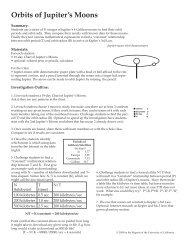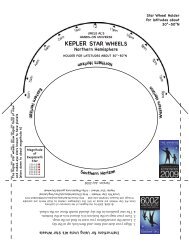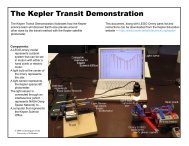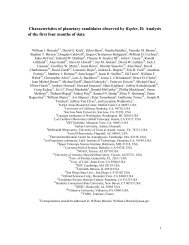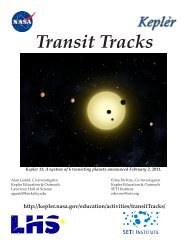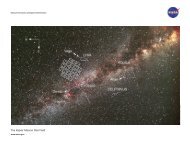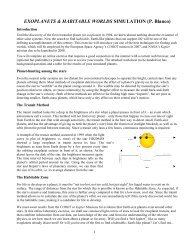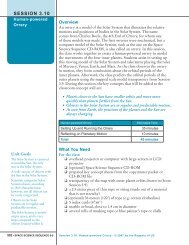Poster Abstracts - Kepler - NASA
Poster Abstracts - Kepler - NASA
Poster Abstracts - Kepler - NASA
- No tags were found...
Create successful ePaper yourself
Turn your PDF publications into a flip-book with our unique Google optimized e-Paper software.
POSTER ABSTRACTSP0401. POSTER SESSION ISPIN-ORBIT ALIGNMENT OF TRANSITING PLANETARY SYSTEMS FROM RM EFFECTOBSERVATIONS USING CYCLOPS.Brett Addison 1 , Duncan Wright 1 ,and Chris Tinney 1 , 1 Department of Astrophysics and Optics,University of New South Wales, NSW 2052, Australia. b.addison@student.unsw.edu.auIntroduction: Over 500 extrasolar planets havebeen discovered over the last decade and a half withmany more to be discovered in the next couple ofyears. In addition to discovering new extrasolar planets,a detailed analysis of their structure, composition,and other bulk properties is also needed in order togain an understanding of the processes involved in theformation of planets in other systems as well as in ourown solar system.The Exoplanetary Science group at UNSW iscommissioning a Cassegrain-fed optical-fiber bundlecalled CYCLOPS at the Anglo-Australian Telescope(AAT) to carry out Doppler spectroscopy of transitingplanet candidate stars arising from Southern Hemispheretransit searches. In addition, our team willcarry out measurments of the Rossiter-McLaughlin(RM) effect in transiting exoplanets. The RM effect isa spectroscopic anomaly in the radial velocity curvethat arises when a planet occults a small spot on therotating disk of its host star. This in turn causes asymmetricdistortions in the line profiles of a star's spectrumcreating the apparent anomaly seen in the radialvelocity curve (1). The detection of this effect allowsus to estimate the spin-orbit alignment of transitingplanetary system which is a critical component in orderto study the processes involved in planetary formationand migration.CYCLOPS: CYCLOPS is an upgrade for theAAT’s existing UCLES coude-echelle spectrograph. Itreplaces the five mirror Coude train, with aCassegrain-fed optical-fiber bundle, which reformatsan area of 4.7 square arcseconds on the sky (formattedas fifteen 0.6” diameter hexagons) into a pseudo-slit of15 fibers at the entrance of UCLES. Each fibre at theentrance slit has a diameter of 0.61”, which delivers aresolution of λ/Δλ = 70,000. Commissioning testsdemonstrate CYCLOPS delivers 70% more photons toour spectrograph than the old mirror train, and does soat 50% higher resolution (2).Spin-orbit Alignment of Transiting Exoplanetsand the Rossiter-McLaughlin Effect: Observing theRM effect provides an estimate of the alignment of theprojected stellar spin axis to the orbital plane of theplanet known as “spin-orbit” alignment, measured bythe angle (λ). This information is critical in order toplace constraints and test different theories on planetaryformation and migration (1). Using bothCYCLOPS and UCLES, our team will follow up anumber of transiting planet candidate stars arising fromthe HAT-South transit search with high precision radialvelocity both during and out of the transit phase.Our team has also developed a chi squared minimizationanalysis model called ExOSAM (ExoplanetaryOrbital and Simulation Analysis Model) to estimatevsini and λ by comparing the observed RM effect datato our theoretical model. We have tested ExOSAMwith actual data obtained for Wasp-18 (3). We findthat λ = 4° and vsini = 11.6 km/s for this system. Figure1 shows the RM anomaly in the radial velocitymodeled using ExOSAM with Wasp-18 data duringtransit.Conclusion: The Exoplanetary Science group atUNSW has commissioned a Cassegrain-fed opticalfibrebundle spectrograph called Cyclops at the AATto carry out Doppler spectroscopy and measurmenetsof the RM effect of transiting planet candidate starsarising from the HAT South transit survey. This researchwill allow us to estimate the orbital parametersand mass of transiting exoplanets, critical componentsneeded to study their structure and formation processesas well as their migration history.Figure 1 RM anomaly in the radial velocity modeledby ExOSAM with data obtained during the transit ofWASP-18 b (Triaud et al. 2010). The underlying <strong>Kepler</strong>iantrend of the star’s orbit due to the planet hasbeen removed for clarity.References: [1] Ohta, Taruya & Suto (2004) Nat.,90, 1151–1154.[2] http://www.phys.unsw.edu.au/~cgt/CYCLOPS/CYCLOPS.html. [3] Triaud et al. (2010) A&A, 524, A25.1602011 <strong>Kepler</strong> Science Conference - <strong>NASA</strong> Ames Research Center



